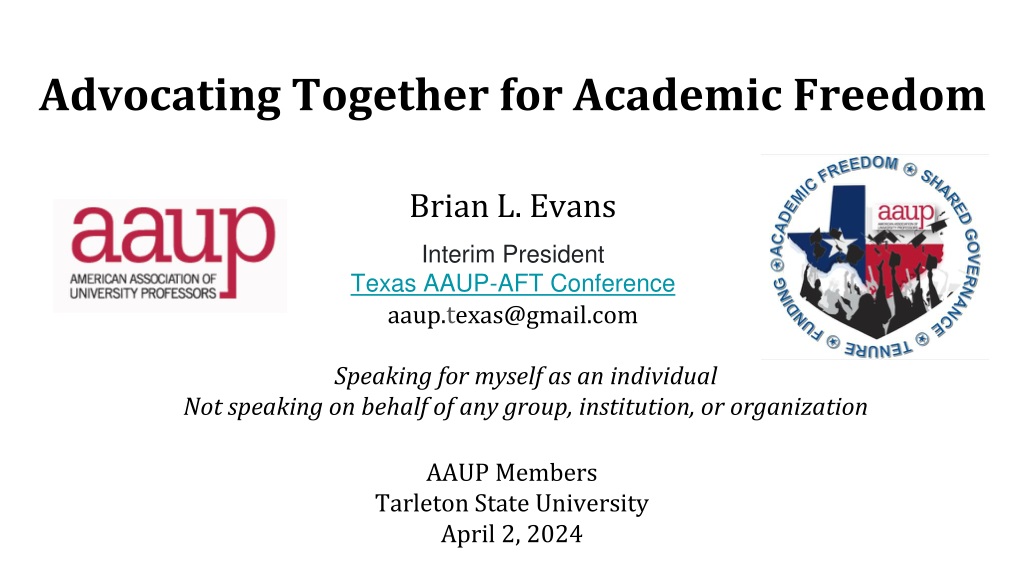

0 likes | 0 Vues
Brian L. Evans, the Interim President of Texas AAUP-AFT Conference, advocates for academic freedom and shared governance as crucial for quality education. The AAUP champions academic freedom and safeguards include tenure and shared governance. Faculty have decision-making authority in various areas, and advocacy for higher ed values is highlighted, emphasizing the importance of academic freedom, tenure, and shared governance in teaching, research, and expression.

E N D
Advocating Together for Academic Freedom Brian L. Evans Interim President Texas AAUP-AFT Conference aaup.texas@gmail.com Speaking for myself as an individual Not speaking on behalf of any group, institution, or organization AAUP Members Tarleton State University April 2, 2024
American Association of University Professors AAUP founded in 1915 by faculty and has 45,000 members. AAUP champions academic freedom, advances shared governance, and organizes all faculty to promote economic security and quality education. AAUP affiliated with the American Federation of Teachers (1.7M members including 148,000 professors) Aug. 2022 Consider Joining AAUP
1940 Joint AAUP/AAC&U Statement of Principles on Academic Freedom & Tenure (2600 words) Amer. Assoc. Colleges & Universities (AAC&U): 860+ institutions Academic Freedom for teachers consists of interrelated elements ● freedom to explore all avenues of scholarship, research, and creative expression and to publish the results of such work ● freedom to discuss all relevant matters in the classroom ● freedom from institutional censorship or discipline when speaking or writing as participants in the governance of an educational institution ● freedom from institutional censorship when speaking or writing as a citizen Free inquiry, free expression, and open dissent are critical for student learning and the advancement of knowledge Safeguards include tenure, due process, shared governance Texas A&M System 12.01 Academic Freedom, Responsibility and Tenure 1940 Statement: https://www.aaup.org/report/1940-statement-principles-academic-freedom-and-tenure
1966 Statement on Government of Colleges and Universities (3500 words) Jointly formulated by Faculty (AAUP), Presidents (ACE) and Trustees (ACB) ● American Council on Ed. (ACE): 1500+ institutions including Texas A&M University-Central Texas and Texas A&M University System Office Assoc. of Gov. Boards of Univ. & Colleges: 1300+ members including Texas A&M University System Board of Regents Faculty have primary decision-making authority in • Curriculum, subject matter, and methods of instruction • Those aspects of student life which relate to educational process • Matters related to faculty status – appointments, reappointments, decisions not to reappoint, promotions, granting of tenure, and dismissal • “President should exercise adversely only in exceptional circumstances, and for reasons communicated to the faculty” & receive faculty feedback Faculty have authority in financial exigency and program closures 1966 Joint Statement, https://www.aaup.org/report/statement-government-colleges-and-universities ●
1966 Joint AAUP/ACE/AGB Statement on Government of Colleges and Universities President shares responsibility in Definition and attainment of goals Administrative action Communications to link components of academic community President provides institutional leadership Innovate, initiate, and persuade others to work toward goals Utilize judgments of the faculty and outside competent scholars Ensure standards and procedures conform to policy established by the board and standards of sound academic practice Manage and create resources President represents institution to public ● ● ● ● ● ● ● 1966 Joint Statement, https://www.aaup.org/report/statement-government-colleges-and-universities
1966 Joint AAUP/ACE/AGB Statement on Government of Colleges and Universities “Maintains a general overview of the institution” • Entrusts conduct of administration to administrative officers • Entrusts conduct of teaching and research to the faculty Publishes codified statements defining policies and procedures Provides long-term resource planning and oversees endowment Obtains capital and operating funds Supports institution when “ignorance or ill will threatens” any part “In grave crises it will be expected to serve as a champion.” Governing Board Roles 1966 Joint Statement, https://www.aaup.org/report/statement-government-colleges-and-universities
Legislative and Community Advocacy Higher ed is a mystery to Legislators and the general public 48% of Texans aged 25-64 have enrolled in an institution of higher ed 30% of Texans aged 25-64 have completed higher ed certificate or degree Advocacy is telling your story about how higher ed helps our state Why are academic freedom, tenure, shared governance, and other higher ed values are important to you in teaching, research and expression? How has the teaching and research in your discipline benefitted Texans? As a private citizen, you have freedom to express your views per First Amendment Rights – be clear who you are speaking for And you can team up with a group to advocate…. • • • •
Texas AAUP Conference Members at 75 universities, comm. colleges, health-related inst. AAUP affiliated with Amer. Federation of Teachers Aug. 1, 2022 Advocacy for higher ed values Ramped up by Texas AFT (10/22) and NAACP LDF (2/23) Wrote op-eds and blogs, and tweeted @TexasAaup Interviewed with reporters ** Created a higher ed bill tracker Coordinated with 10 higher ed advocacy orgs Legislative training, updates and visits ** Testifying at Texas Senate and House committee hearings ** Campaigns for Legislative outreach ** • • • • • • ** As private citizens / AAUP members •
Advocacy Outcomes In the House, our coordinated effort among 10 higher ed advocacy orgs Able to change the legal definition of tenure in tenure bill from one- year guaranteed contracts to continuous employment. Influenced changes in anti-DEI bill including several exceptions for external grants. Helped defeat the censorship bill • • • Karma R. Chávez, Lessons from AAUP Advocacy in Texas, Academe, 2023. How a revived AAUP chapter and a coalition of allies mobilized against a legislative assault.
Thank You! Consider joining AAUP Consider forming an AAUP Chapter on campus Helps faculty connect with other faculty across campus Gives training on academic freedom, departmental and college governance, and how to get your voices heard Works with Faculty Senate to change policies and encourages members to run for Faculty Senate Provides faculty mentoring Hosts seminars on academic freedom Gives training in Legislative advocacy Advocates at the State Legislature • • • • • • •